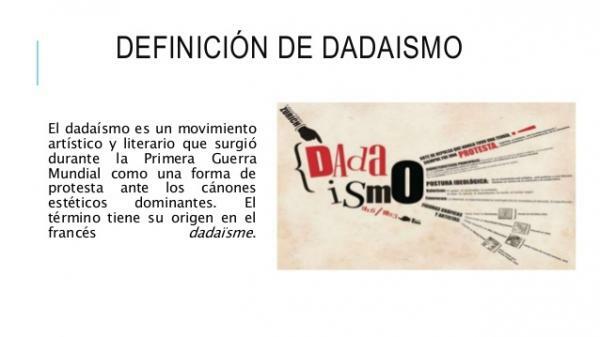Dadaism: works and authors

Within the literary and artistic movement baptized as "Avant-garde", there were undercurrents known as" isms "and refer to different aesthetics and ideologies that were disruptive with tradition and that they sought to offer a type of artistic expression inspired by their reality and the modernity that the world was living. One of these movements was Dadaism, a current that emerged in Switzerland in 1916 from the hand of the artist considered as its founder: Tristan Tzara. In this lesson from a TEACHER we are going to show you the Dada works and their authors so that you know literary Dadaism and its main exponents. We started!
Before getting to know the most outstanding works of Dadaism, it is important that we pause for a moment in the description of this movement itself. literary avant-gardes of the 20th century. Dadaism arose in the city of Zurich in 1916 and is also known as "Dada Movement " It arose from the hand of a group of artists who were in the Swiss city as refugees, due to the First World War.
The Dadaists were artists from different fields such as painting, sculpture and, of course, literature that they sought. break away from traditional art to find a new voice adapted to its historical context. They were committed to maximum creative freedom, with anarchist overtones and a complete break with the past. In fact, the very name of the movement (Dada) was selected at random: they looked for a random name in the dictionary to name the artistic movement. With this act it is clearly reflected that the character they were pursuing was that of put reason aside and open the doors to chance.
Origin of Dadaism
The founder of Dadaism is considered to be Tristan tzara who, along with other artists such as Hugo Ball and Hans Arp, created a manifest in which the bases of the Dada movement were specified. What they sought was to offer a new vision of the world, since World War I had created great havoc in reality and, also, in art.
The main intention of Dadaism was to break with all artistic codes and bet on a new expression adapted to your reality. This expression, linked to the experience of the Great War, could only be one way: anti-poetic and anti-artistic.
Although it arose in Switzerland, in a short time the movement expanded and reached other European cities such as Berlin, Paris or Barcelona, but it also reached New York.

Image: Slideshare
We have already commented that the author of Dadaism Tristan Tzara created a manifesto in which he specified what were the artistic and ideological bases of the movement. Here is a summary of the characteristics of Dadaism that appeared from the hand of its founders:
- Breaking off with any prior art code or standard.
- Search for a new way of making art leaving logic and cultivating and humor.
- Literature hard to read. Dadaist authors preferred to create striking sounds and images rather than logical words.
- The act of creating gains more importance than the result of artistic creation.
- Bet on it individual, spontaneous and casual.
- Although Dadaism is currently being studied within the vanguards, the truth is that the Dadaists opposed this trend because it had been systematized.
- It is considered an "anti-art" by the will that the members of the current themselves defended.
- The artistic improvisation.
- The artists were against the war, as well as the bourgeoisie. Materialism was rejected and there was a constant critique of capitalism and the consumer society.
Characteristics of literary Dadaism
But to focus more specifically on literary Dadaism, below we are going to detail what are the most differentiating elements in this type of art.
- Transgressive and revolutionary poetry
- Writers and poets felt rebellious and misunderstood in society
- Simultaneous poems were very successful
- The poems could be recited in several languages due to the international character of the group itself (especially in English, German and French)
- The content of the poems or the writings was not understood, since sound and mental images that were created prevailed over logic and understanding
- The Dadaists created static poems, that is, poems that were placed on a chair that was placed on a stage, and each time the curtain was lowered and raised, a new message would appear.

Image: Slideshare
We are going to discover you already Dada works and the most important authors so that you can get closer to the artistic creation of some of them and better understand how this fascinating and original artistic movement was. It is important to bear in mind that Dadaism was a brief but very important current for its desire to break with logic and with the established order.
- Tristan Tzara: He is the most outstanding Dadaist author since he is considered the father of the movement and the greatest exponent. He created the Dadaist manifesto in which the ideology and the foundations of the current were collected.
- Jean Art: Along with Tzara, Jean Art is also considered one of the founders of this movement. He was characterized by cultivating both Dadaist painting and poetry. Work: "Collage with squares arranged according to the laws of chance" (1916) by Jean Arp.
- Marcel Duchamp: Marcel Duchamp was another of the most recognized Dada artists. Of French origin, his work was very influential in the evolution of this aesthetic. Works: "Fountain" (1917) by Marcel Duchamp and "LHOOQ" (1919).
- Guillaume Apollinaire: Poet, novelist and essayist, Apollinaire was well known for his "Calligrams" poems. He considers himself both a surrealist and a Dadaist as he explores different techniques of both aesthetics.
- Amedeo Modigliani: Italian painter and sculptor who is well known for his paintings in which people appear elongated with naked faces and figures.
- Ramon Gomez de la Serna: Within the Spanish Dada movement we highlight Gómez de la Serna, a journalist and writer who promoted the literary genre of the "greguería" and who is usually classified within the generation of 14.
The Dada movement also had the support of other creators of the time such as the poet André Bretón, the founder of the Surrealism.
So that you understand what the poetry of this current was like, here we leave you the Tristan Tzara's instructions for making a Dadaist poem:
Pick up a newspaper.
Take a pair of scissors.
Pick an article in the newspaper the length you plan to give your poem.
Cut out the article.
Then carefully cut out each of the words that make up that article and put them in a bag.
Shake it gently.
Then take out each cutout one after the other.
Thoroughly copy the poem in the order it came out of the bag.
The poem will resemble you.
And you are "an infinitely original writer with a bewitching sensibility, although misunderstood by the common people"
The trace of Dadaism has been seen over time, especially in artistic techniques such as "collage" or the mixture of different genres. This technique began to be created by the hand of these creators and they persist today.




